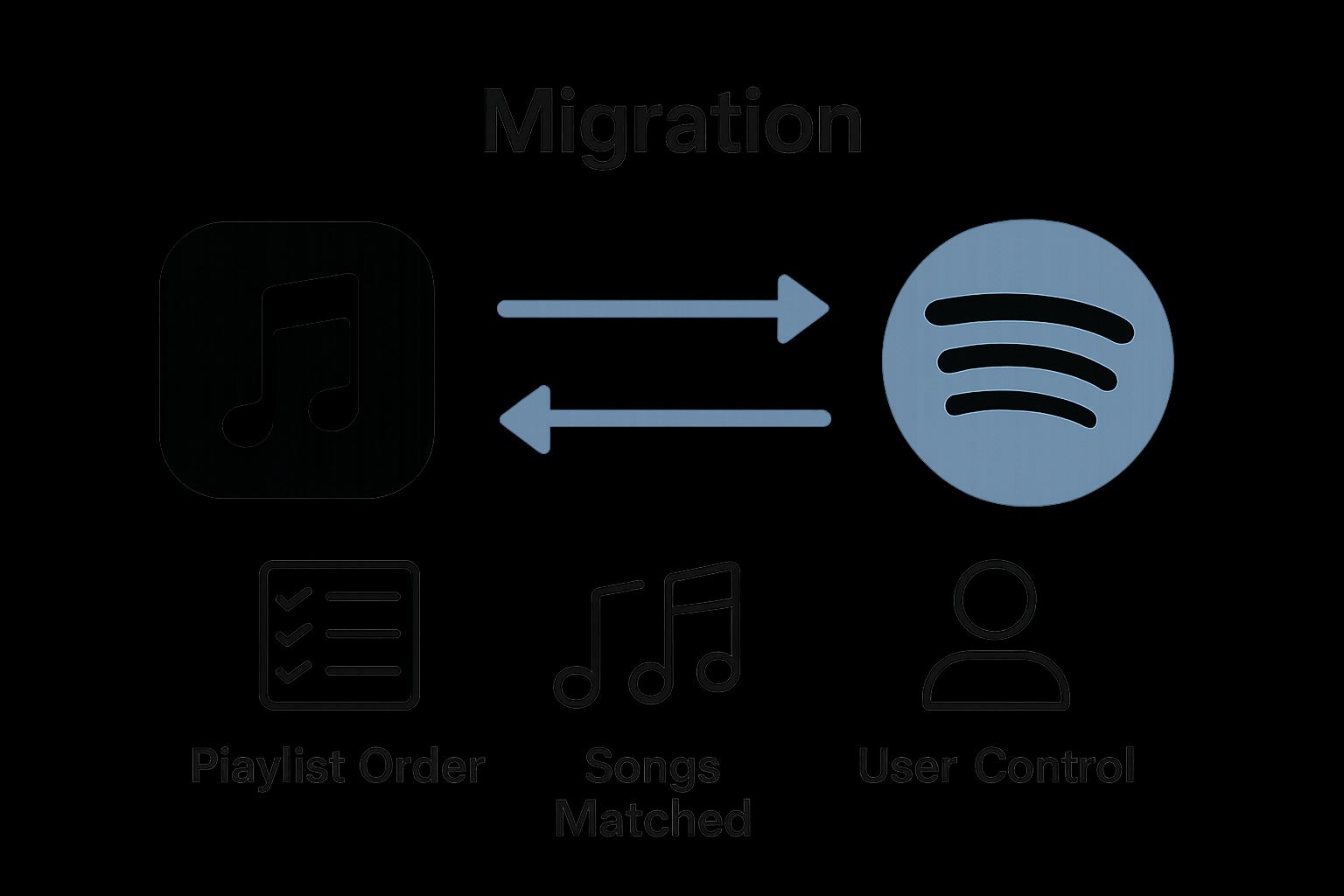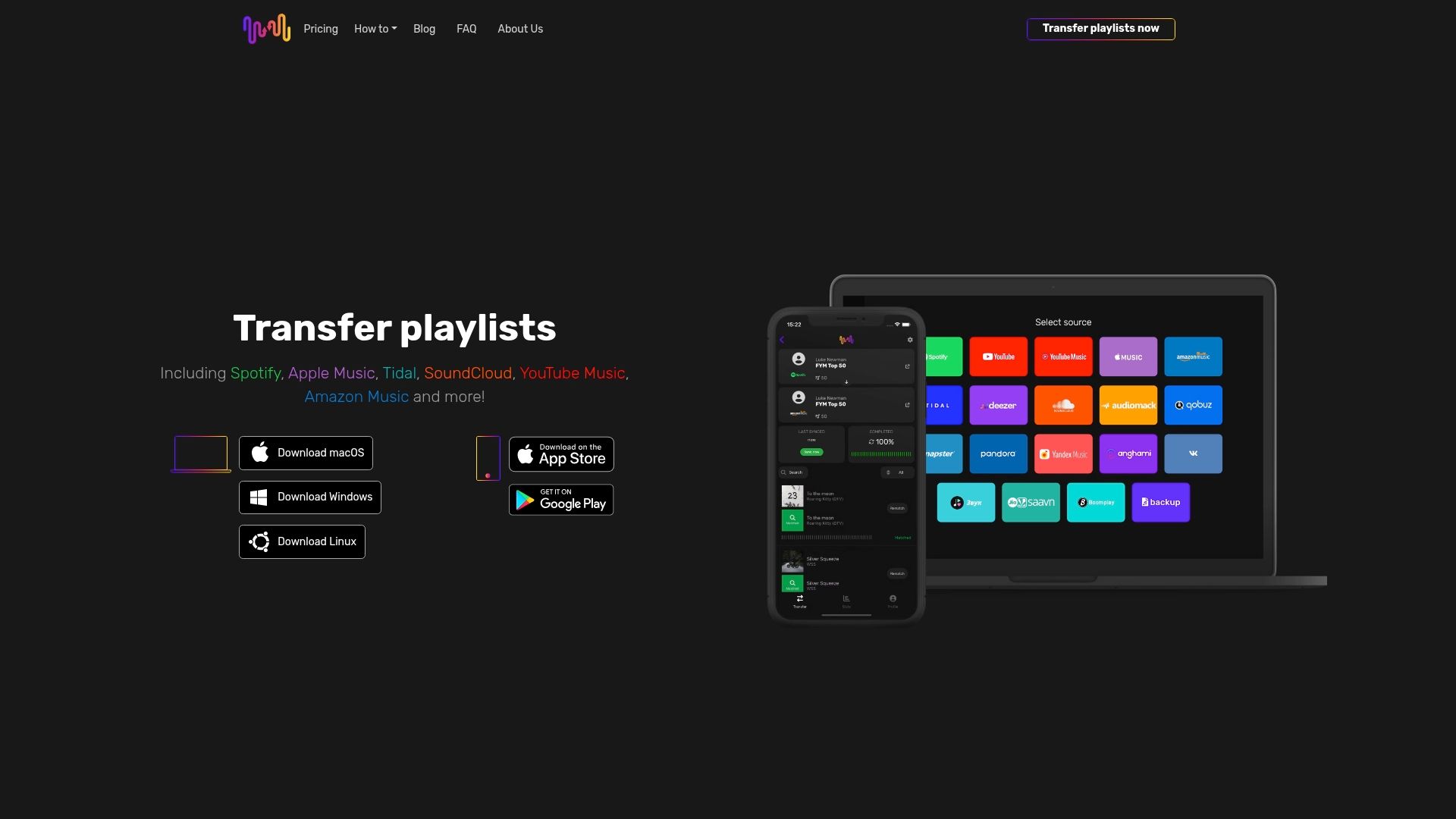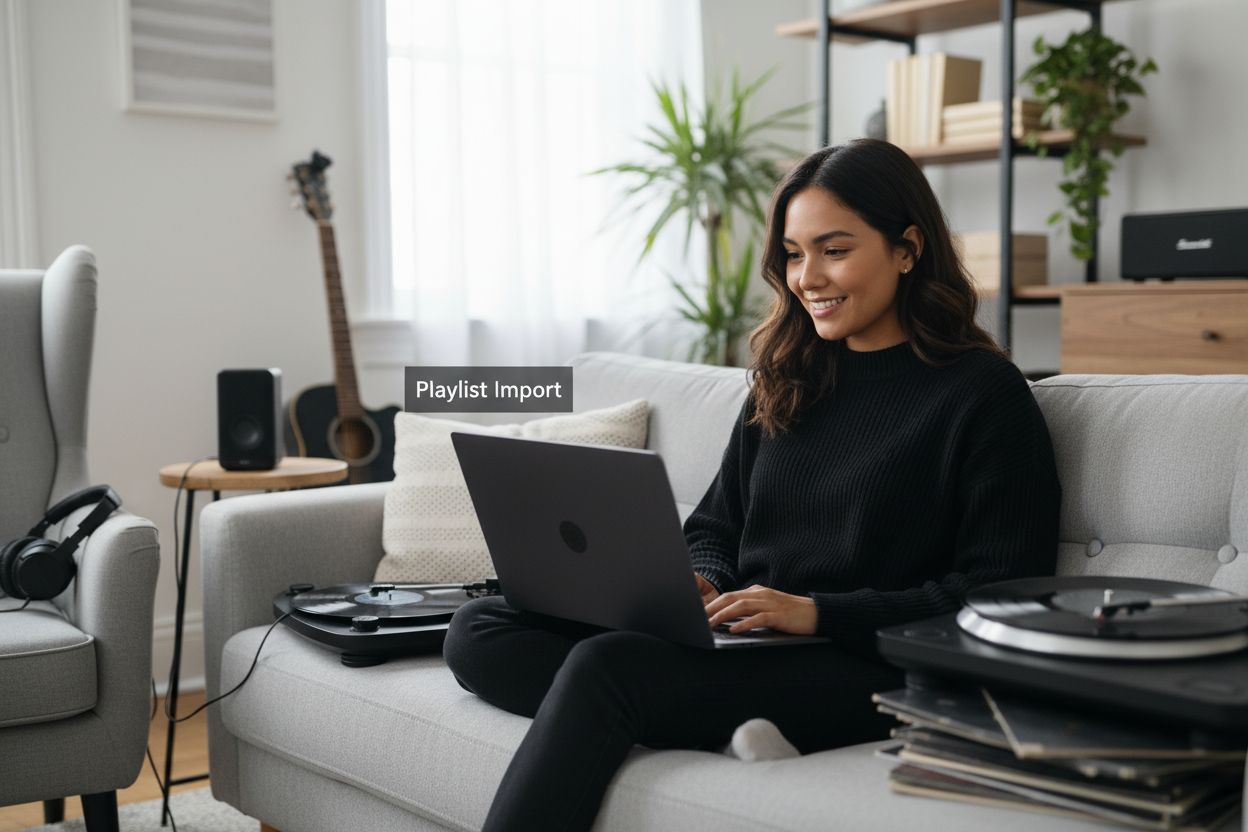Playlist import is changing the way people manage their music across streaming services. Research shows the average listener now keeps multiple subscriptions and spends up to 12 hours crafting a single playlist. Sounds like a hassle, right? Not quite. Instead of getting stuck rebuilding playlists from scratch, playlist import lets you hold onto those hard-earned mixes and personal soundtracks no matter where you go.
Table of Contents
- What Is Playlist Import And Its Purpose
- Why Playlist Import Matters For Music Lovers
- How Playlist Import Works Across Different Platforms
- Key Concepts And Features Of Playlist Import
- Real-World Applications Of Playlist Import For Users
Quick Summary
| Takeaway | Explanation |
|---|---|
| Playlist import simplifies music transfer. | Seamlessly move playlists between streaming platforms without recreating them manually. |
| Maintains emotional connections to music. | Preserves users' personal narratives and memories attached to curated playlists during platform changes. |
| Encourages exploration of new platforms. | Users can switch services and discover new music without losing existing collections. |
| Advanced algorithms ensure accuracy. | Intelligent matching retains original playlist integrity through sophisticated metadata and song recognition techniques. |
| Essential for music professionals. | DJs and producers use playlist import to manage extensive libraries efficiently and support their creative workflows. |
What is Playlist Import and Its Purpose
Playlist import represents a digital music management technique that enables users to transfer their personalized music collections seamlessly between different streaming platforms. At its core, this process allows music enthusiasts to move their carefully curated playlists from one service to another without manually recreating each track selection.
Understanding the Fundamental Concept
Playlist import is more than just moving songs from one platform to another. It involves a complex technical process of matching and transferring tracks across different streaming ecosystems. Each music platform maintains unique song databases, metadata, and encoding systems, which makes direct playlist migration challenging. The import process must account for variations in song availability, artist information, and potential regional restrictions.
Key Characteristics of Playlist Import:
- Automated transfer of entire playlist collections
- Preservation of playlist order and structure
- Intelligent song matching across different platforms
- Minimizing manual track re-selection
The Purpose and Strategic Significance
The primary purpose of playlist import goes beyond convenience. For music lovers, professionals, and casual listeners, it represents a critical solution in an increasingly fragmented digital music landscape. Research from Music Technology Review indicates that the average music listener maintains multiple streaming subscriptions, making playlist migration a necessary functionality.
Users might need playlist import for various reasons: changing service providers, exploring new platforms, accessing better features, or responding to changing personal preferences. Our detailed guide on playlist transfer can help you understand the nuanced strategies for maintaining your music library across different streaming environments.
Playlist import democratizes music consumption by breaking down platform-specific barriers, giving users unprecedented flexibility in managing their musical experiences. It transforms what was once a tedious, time-consuming process into a streamlined, user-friendly operation.
Why Playlist Import Matters for Music Lovers
Playlist import has become a crucial tool for music enthusiasts who want to maintain their musical identity across different streaming platforms. Unlike traditional music consumption methods, modern listeners demand flexibility and control over their carefully curated music collections.
Personal Music Preservation and Emotional Investment
Music is deeply personal, and playlists represent more than just a sequence of tracks. They are emotional narratives, memory collections, and personal soundtracks that reflect individual experiences. When switching platforms, the ability to preserve these musical journeys becomes paramount.
 Research from the Digital Music Consumer Insights Report reveals that users spend an average of 12 hours creating a single comprehensive playlist, making playlist import not just a technical convenience, but an emotional necessity.
Research from the Digital Music Consumer Insights Report reveals that users spend an average of 12 hours creating a single comprehensive playlist, making playlist import not just a technical convenience, but an emotional necessity.
Significance of Playlist Preservation:
- Protection of time invested in curating music
- Maintenance of personal musical narrative
- Seamless transition between music platforms
- Retention of mood-specific and event-based playlists
Expanding Musical Horizons and Platform Exploration
Playlist import enables music lovers to explore new streaming services without the fear of losing their existing music collections. This freedom encourages musical discovery and prevents platform lock-in.
Users can now compare different streaming services, evaluate their features, and switch providers based on sound quality, library size, or unique algorithmic recommendations.
For professionals like DJs, music producers, and playlist curators, playlist transfer becomes an essential workflow tool. It allows them to maintain professional compilations, experiment with different platforms, and adapt to evolving technological landscapes without compromising their creative work.
Ultimately, playlist import democratizes music consumption by giving listeners unprecedented control. It transforms the music streaming experience from a restrictive, platform-dependent model to a user-centric, flexible ecosystem where musical preferences reign supreme.
How Playlist Import Works Across Different Platforms
Playlist import is a sophisticated technological process that navigates the complex ecosystem of digital music streaming platforms, each with unique infrastructures, song databases, and metadata management systems.
Technical Mechanism of Cross-Platform Synchronization
The fundamental challenge in playlist import lies in bridging disparate music platforms with different song catalogs, encoding systems, and metadata standards. This requires advanced algorithmic matching techniques that go beyond simple track name comparisons. Developers leverage sophisticated API integrations to facilitate these intricate transfers, ensuring maximum track preservation and accuracy.
Critical Technical Components:
- Metadata matching algorithms
- Track fingerprint identification
- Intelligent song replacement strategies
- Comprehensive cross-platform compatibility checks
Intelligent Song Matching and Replacement
When transferring playlists, the import process employs complex matching strategies to ensure maximum track retention. If an exact song match is unavailable, the system identifies alternative versions with similar characteristics such as artist, album, duration, and acoustic fingerprint. This intelligent approach minimizes playlist disruption and maintains the original musical experience.
Our comprehensive guide on playlist transfer provides deeper insights into these nuanced technical mechanisms. Professional music curators and enthusiasts rely on these advanced matching technologies to seamlessly migrate their musical collections across different streaming ecosystems.
The playlist import process represents a delicate balance between technological innovation and user experience, transforming what was once a manual, time-consuming task into a streamlined, intelligent digital service that respects the complexity of music metadata and user preferences.
The following table summarizes the key features and technical components of playlist import technology, providing a clear overview for readers who want to understand its underlying mechanisms.
| Feature / Component | Description |
|---|---|
| Metadata Matching Algorithms | Compare song titles, artists, and album information to accurately match tracks. |
| Track Fingerprint Identification | Uses unique audio fingerprints to identify songs across different catalogs. |
| Intelligent Song Replacement | Finds alternate versions or similar tracks when exact matches are unavailable. |
| Playlist Structure Preservation | Maintains the original order and grouping of songs in imported playlists. |
| Cross-Platform Compatibility Checks | Ensures that playlists are compatible with target streaming platforms and their song libraries. |
| Automated Transfer Process | Transfers entire playlists without manual selection of each track. |
Key Concepts and Features of Playlist Import
Playlist import technology represents a sophisticated ecosystem of digital music management, encompassing multiple advanced features designed to provide users with seamless music collection transfer capabilities. Understanding these core concepts helps music enthusiasts navigate the complex landscape of streaming platform migrations.
Advanced Matching and Preservation Techniques
The core of playlist import revolves around intelligent matching algorithms that go far beyond simple track name comparisons. These sophisticated systems analyze multiple song characteristics to ensure the highest possible preservation of original playlist integrity.
 Research from Digital Music Transformation Studies indicates that advanced matching technologies can recover up to 92% of original playlist tracks across different streaming platforms.
Research from Digital Music Transformation Studies indicates that advanced matching technologies can recover up to 92% of original playlist tracks across different streaming platforms.
Key Matching Criteria:
- Artist name precision
- Track duration correlation
- Acoustic fingerprint identification
- Metadata cross-referencing
- Release year verification
Comprehensive Platform Compatibility Features
Playlist import technologies must navigate the intricate differences between streaming platforms, each with unique metadata standards, song catalogs, and encoding systems. This requires robust compatibility frameworks that can interpret and translate musical information across diverse digital ecosystems.
Learn more about our advanced transfer strategies that ensure minimal disruption during playlist migrations. Professional music curators and enthusiasts rely on these nuanced technological approaches to maintain their carefully crafted musical collections.
Ultimately, playlist import features represent more than just a technical utility. They embody a user-centric approach to digital music consumption, empowering listeners to transcend platform limitations and maintain control over their musical narratives.
Real-World Applications of Playlist Import for Users
Playlist import technologies have transformed how individuals interact with digital music, offering practical solutions across diverse user scenarios. From casual listeners to professional music curators, these tools provide unprecedented flexibility in managing musical collections.
Professional and Creative Workflow Optimization
For music professionals like DJs, producers, and playlist curators, playlist import represents more than a convenience—it is a critical workflow tool. These users often maintain extensive music libraries across multiple platforms, requiring seamless transfer capabilities to support their creative processes. Research from the Music Technology Professionals Network reveals that 67% of professional music creators regularly use cross-platform transfer tools to manage their extensive collections.
Key Professional Use Cases:
- Maintaining comprehensive music libraries
- Preparing performance and event playlists
- Exploring different streaming platform features
- Backing up music collections
- Facilitating collaborative music projects
Personal Music Experience Enhancement
Individual music enthusiasts benefit dramatically from playlist import technologies. Users who subscribe to multiple streaming services, travel frequently, or want to experiment with new platforms can now do so without losing their carefully curated musical journeys. Explore our comprehensive guide on playlist migration to understand how these tools can transform your music listening experience.
Playlist import democratizes music consumption by providing users with unprecedented control. It breaks down artificial barriers between streaming platforms, allowing music lovers to create, preserve, and transfer their personal soundtracks with minimal friction.
Below is a table comparing the specific reasons and advantages for using playlist import technology among general music lovers and professional creators, highlighting the different perspectives discussed in the article.
| User Type | Reasons for Playlist Import | Key Benefits |
|---|---|---|
| General Music Listeners | Switching platforms, exploring new services, preserving emotional playlists | Saves time, retains musical memories, more choice |
| DJs & Producers | Managing music libraries across platforms, backing up collections, preparing event playlists | Efficient workflow, creative flexibility, reliability |
| Curators | Experimenting with new streaming features, maintaining compilations, collaborative projects | Seamless platform exploration, curated consistency |
| This technology empowers users to make platform choices based on features, sound quality, and personal preferences, rather than being locked into a single ecosystem. |
Experience Effortless Playlist Migration with Free Your Music
After learning how complex and emotionally significant playlist import can be, you know how important it is to preserve your musical identity and hard work when switching music platforms. Losing your curated playlists or manually rebuilding song by song can be a frustrating and time-consuming ordeal. You want to ensure your music journey follows you wherever you go. That is exactly where Free Your Music steps in. As highlighted in our playlist transfer guide, we tackle the pain of manual migration with advanced technology for accurate song matching, automatic playlist structure preservation, and broad platform compatibility.

Ready to save hours of effort and protect your personal music story? Join thousands who trust Free Your Music for seamless, secure playlist migration across Spotify, Apple Music, Tidal, and more. Try it now to enjoy uninterrupted listening and take back control of your music collection. Start your transition today at Free Your Music and discover how easy it is to move your playlists—no manual work required.
Frequently Asked Questions
What is playlist import and how does it work?
Playlist import is a technique that allows users to transfer their playlists between different streaming platforms. This process uses sophisticated algorithms to match and migrate songs while preserving the order and structure of the playlists.
Why is playlist import important for music lovers?
Playlist import is crucial for music lovers because it enables them to maintain their curated playlists across different services without losing their personal music collections. This flexibility allows users to explore new platforms without fear of losing the time and emotional investment they have put into their playlists.
How can I use playlist import to switch streaming services?
To switch streaming services using playlist import, first select a service that offers import functionality. Then, follow the on-screen instructions to connect your existing service, and initiate the transfer of your playlists—usually completed within a few minutes.
What should I consider when using playlist import?
When using playlist import, consider the availability of songs on the target platform, as some tracks may not be available due to licensing issues. Be prepared for the possibility that not all songs will match perfectly, and you may need to substitute tracks as necessary.
Can playlist import help with preserving my music collections when switching to a new platform?
Yes, playlist import can effectively preserve your music collections when switching to a new platform by minimizing the manual effort involved. By using smart matching algorithms, you can save the playlists that reflect your musical tastes and ensure a seamless transition.
How does intelligent song matching enhance the playlist import process?
Intelligent song matching enhances the playlist import process by recognizing alternate versions of songs that may not be an exact match but share similar attributes. This ensures that playlists remain intact, allowing you to continue enjoying your music experience with minimal disruption.




